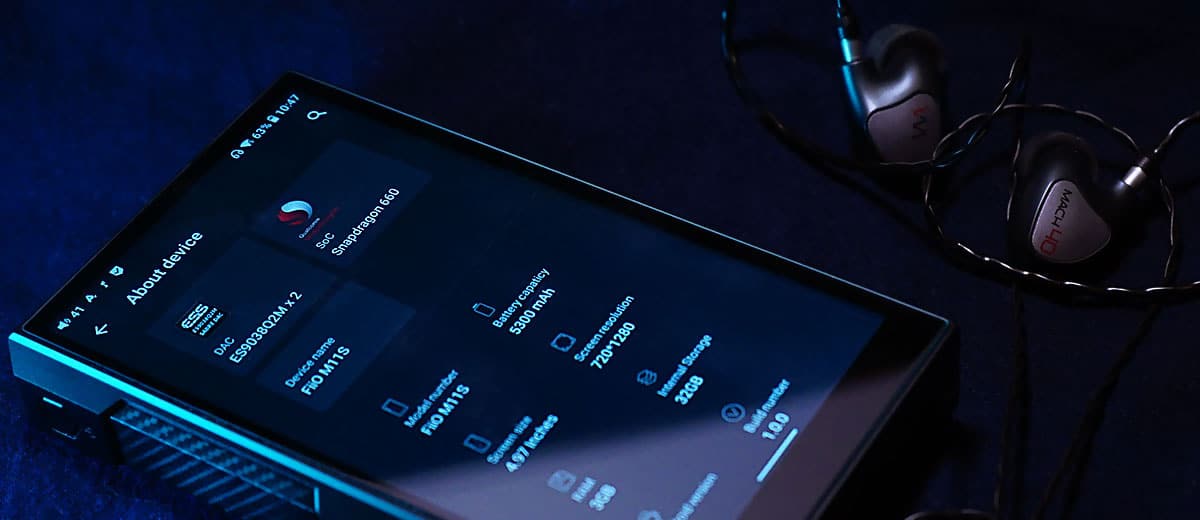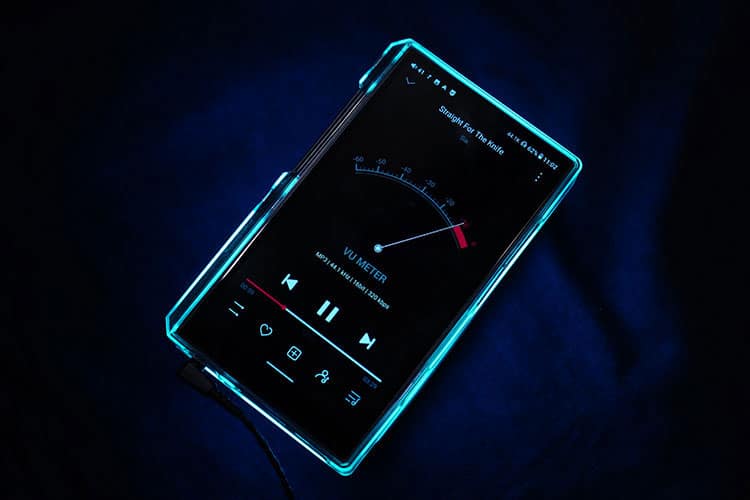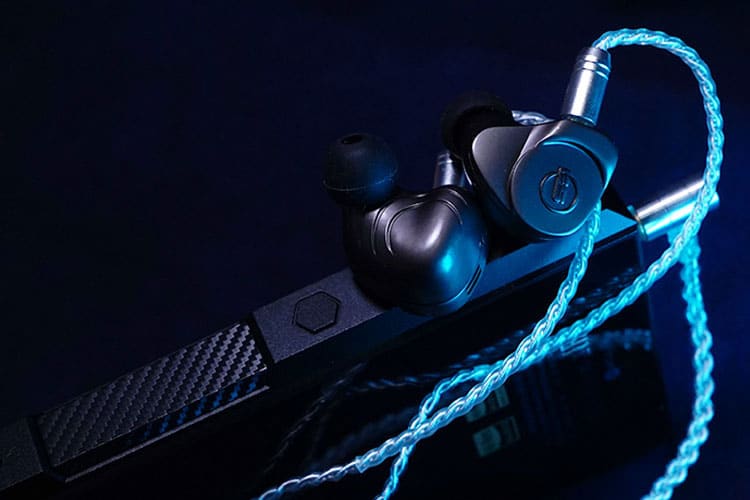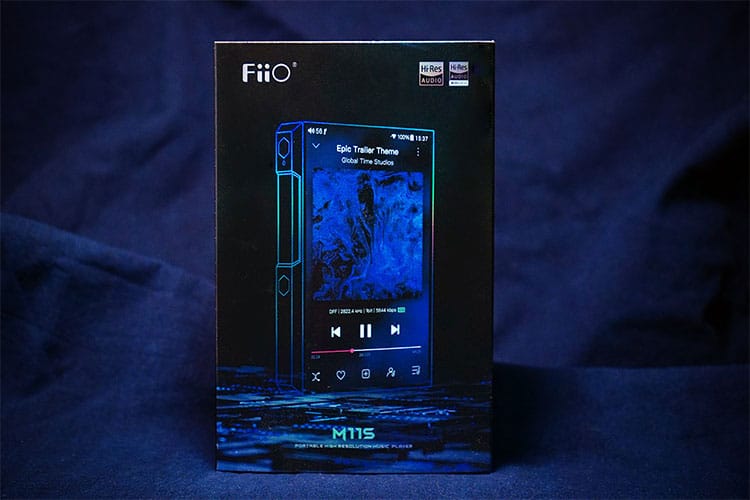Sound Impressions
Summary
The M11S has been burnt in for around 2 weeks and with the powerful 670mW output it sounds quite a bit more refined and resolving in the mids than the original M11.
The mid-bass has a lot of presence but it is the ample energy in the upper vocal range that steals the attention, pumping up the dynamics and bringing the vocal more forward.
I would classify it as an M-shape tuning where both ends have a fair extension and transients in the mid-bass and upper mids are prominent.
Output power is more limited on single-ended connection so the balanced output would be recommended unless you plan to use it with an amplifier. The below impression is based on firmware version 1.0.0 and mainly on 4.4mm output.
Timbre
The M11S is tuned to sound energetic, with a moderately fast bass decay, clean treble tuning, and a rather sharp roll-off.
It stresses the upper mids for clarity and intensity, you can hear higher notes in the vocal range sounding more prominent and as such it sounds more dynamic and exciting with pops and lighter voices, also favoring streaming content.
The bass on M11S has good agility and doesn’t kick very deep, it carves out more space in the 500Hz area than on the M11, and bass instruments sound more protrusive and separated.
The fundamental bass frequencies are slightly shy but you can still hear them boom subtly at the back, while the mid-bass is quite elevated and I find boosting the lower bass frequencies slightly to be more natural sounding and less boxy.
The mids on the M11S are satisfactorily detailed and smoothly delivered, which complements the more aggressive mid-treble to give stronger penetration power. The upper vocal frequencies are more weighted than the body, giving softer voices more presence and pushing the vocal imaging more forward, though it may get slightly hot at times.
The tuning direction also makes the M11S a good match for bass guitars, saxophones, and woodwind instruments aside from pops and streamed content, transient tones are boosted to bring out the brilliance in overtones and colors the output to be more dynamic sounding.
While the treble is not as opened up and airy as on the very extended treble on the M11 Plus ESS, it sounds more smoothened on the M11S with some of the edges and ambiance removed that may help take away the harshness with sharper voices or lossy recordings.
Staging & Dynamics
The M11S has strong dynamic performance, high power in the output, also satisfactory openness and definition within its moderately large headroom. The bass doesn’t punch very deeply but has an airy touch.
The fast decay also enhances instrument separation and definition, allowing clear identification of instrument positioning that works well with smaller ensembles.
Although the upper vocal range sounds quite intense its rounded top end dampens the output and takes away some air and sheen from live recordings as well as brass instruments. That may color them sweeter, exciting but free from harshness, but it feels more confined when more instruments come into the mix.
Comprehensively, the headroom resembles a small live house that can accommodate and image clearly a small band, sounding powerful in the bass and exciting with the lead singer. It doesn’t define everything as painstakingly clearly as on stronger players like the M11 Plus ESS, but the colorings help Pops, R&B, and Jazz to sound more vivid.
Synergy
Efficiency
FiiO has done a great job regarding noise control even when putting on high gain. It is claimed that the M11S is 62% quieter than its predecessor, with the noise level measured at just 1.8μV which allows very sensitive IEMs like the SE846 to sound almost dead quiet in the background.
If you want to push the performance further, it is recommended to switch off Wi-Fi or use Pure Music Mode.
Pairings
The output impedance measured ≤2.6Ω(32Ω)is slightly on the high side but in practice, the M11S does not sound much flattened with sensitive IEMs and has enough power to drive some demanding multi-BA IEMs or hybrids to sound resolving and dynamic.
Pairing with the Earsonics ONYX it sounds fairly extended and engaging, the vocals are swiftly delivered and there is enough power to open up the treble when using a balanced cable.
Putting on the Westone MACH 60 measured 100dB in sensitivity and 35Ω in impedance, the output sounds quite meaty and smooth, however, the 3.5mm output has more limitation on power and it doesn’t sound as defined as on the balanced output.
Using the 3.5mm stock cable on the MACH 60 the M11S is pushing the treble to stand out more, together with a prominent mid-bass that has a fast impact and clean decay. When switching to a balanced cable the pairing sounds much more defined and firmer in the two ends of the spectrum, the mid-range sounds denser and more distinct in positioning as well.
The M11S has great synergy with IEMs that have stronger bass control and transient response such as the Westone MACH 80 or the SE846 to sound more defined and deeper in staging.
It also works well with various dynamic IEMs to bring the vocal more upfront. With IEMs that are tuned flatter or shyer in the treble, the M11S can boost the overall dynamics and with a few equalizer tweaks, it can further enhance the overall tonal balance and bass presence.
Select Comparisons
FiiO M11 Plus ESS
$799
Technical
The M11 Plus ESS version packs in the same snapdragon 660 CPU, superior ES9068AS chipsets, THX AAA-78 amping module, and a larger 5.5-inch screen. Inside the body of the M11 Plus ESS, there is metallic shielding around key components that pushes the M11 Plus ESS’s technical performance further.
The M11S, despite being quite a bit smaller in size and positioned below the M11 Plus ESS, comes close in terms of raw power, SNR as well as battery time. The system features and the actual user experience are pretty similar.
Design
The design of the M11S is derived from the M11 Plus ESS and it feels 20% smaller in size with the reduction of the lock button and slider function, also taking away the LED rim on the on/off button.
Both DAPs look equally good to me and the smaller size of the M11S is definitely more friendly to carry, however, the weight is not reduced.
Performance
On single-ended output the M11 Plus ESS has an edge in defining the image of every instrument and the vocal clearer and weighting it more life-like and extended in the upper end, also having more depth in its output.
In comparison the M11S has its mids smoothened and the lower mids elevated for stronger attacks, balanced by forwarded upper vocal frequencies and an earlier roll-off but the definition in every part of the spectrum isn’t as strong as on the M11 Plus ESS.
On balanced output, the dynamics get stronger on the M11S and it attacks cleaner in the bass, bringing to the stage fuller, airier attacks with speedy decay. The relatively muted overtones color the vocal more rounded and softer than on the M11 Plus ESS.
Although it does not sound as clearly outlined and strong in penetration power, the vocal performances sound less intrusive, and lighter voices feel sweetened.
Testing with the Westone MACH 40 the M11 Plus ESS sounds more organic and layered in the mid-treble range with swifter articulation throughout its mid-bass to the mids. That helps create a more realistic headroom with better tonal control.
While the M11S is altered in the vocal range to bring up clarity and presence, it colors the output more fun and engaging on planar and dynamic IEMs, especially when listening outdoors.
Shanling M6 Version 21
$569
Technical
The M6 Version 21 with a similar positioning uses dual ES9038Q2M decoding chipsets identical to the M11S. Single-end output on the M6 Version 21 is up to 190mW and balanced drags it up to 570mW.
The S/N ratio gets as high as 127dB on balanced output and output impedance is merely <0.6Ω, which is quite a bit lower than on the M11S.
In terms of system speed, the M11S is smoother with snapdragon 660 compared to the M6 Version 21 which uses the less efficient 28nm snapdragon 430. While being faster in speed the M11S also has prolonged battery time than the M6 Version 21 which makes it handier for traveling.
Design
The M6 Version 21 has a slimmer, longer body with a 4.7” screen plus the signature curved screens, being just a tad bit wider the M11S has a larger 5” screen and a larger screen-to-body ratio which allows more information to be displayed.
The two DAPs are appealing in their own ways. The M6 Version 21 is more rounded and contrasty in colors, whereas the M11S looks stealthier. In terms of portability, both DAPs are quite slim in design and fit well in the pockets of my jeans.
Performance
The M6 Version 21 kicks deeper and tilts more to the bass, sounding meatier in the mid-lows compared to the M11S which feels more hollowed out when listening to thicker voices.
The M6 Version 21 has better vocal authority especially with male vocalists while the M11S’ smoother articulation and boosted upper mids make it a greater match with light voices and the genres like Pops and ACG music.
When testing on the Westone Audio MACH 60 the M11S has a better definition and can separate the vocal more distinctively from the backing instruments.
Listening to strings/ brass instruments the M6 Version 21 sounds fuller in the vocal body but is less exciting and expressive in the overtones compared to the M11S which puts more energy in the 5kHz range. Testing with fast, synthesized bass tracks the perceived resolution is slightly stronger on the M11S, which has a faster and cleaner bass response.
In practice the M11S is more versatile in pairing with different IEMs, there is more power and energy in the upper frequencies to bring out more details and brilliance in the treble, and the overall detail retrieval is stronger.
FiiO M11
$449
Technical
Comparing the specs, we can see nothing but a giant leap in hardware and speed on the M11S than the original M11 which runs on Android 7. The upgraded controller from Exynos 7872 to Qualcomm 660 is turbocharging the navigation and web browsing speed.
The decoder on M11S is switched to dual ES9038Q2M with NDK oscillators compared to M11’s dual AK4493EQ which makes the output more precise and textured. The M11S steps up its SNR performance to 123dB compared to M11’s 118dB, and the background noise level is 60% less than on the M11.
Besides that, the battery size is 1.5x larger and the M11S is capable of outputting 110mW more in its balanced output. Bluetooth version is also upgraded from 4.2 to 5.0, with AAC Codec support that is not featured on the original M11.
Design
The M11S is smaller in size with a cooler, stealthier design using a flat volume knob instead of the scrolling wheel. I won’t say that is an improvement but it does look sleeker, especially with the techier honeycomb button design on the slimmer framework that is heavier.
Another noticeable difference is the charging speed, with the charging voltage stepped from 18W to 27W the M11S charges even faster despite having a 1.5x battery capacity.
Performance
With a Sabre DAC and updated components, the M11S sounds more polished and detailed on the low end. Testing with Nirvana’s Smells Like Teen Spirit, the M11S kicks deeper and sounds more expansive.
The vocal feels more realistically weighted with stronger penetration power and definition compared to the M11 which sounds more altered and compressed.
The midrange frequencies are also livelier and more weighted than on the M11 which sounds comparatively rawer, flatter, hollower, and less as defined in imaging. On the original M11, the upper midrange frequencies are also stressed, but it doesn’t feel as controlled and smoothly rounded.
Our Verdict
Within the sub $500 bracket the FiiO M11S has completely superseded the original M11 by reinterpreting the design, components, and sound tuning.
The high output and engaging signature allow flexible pairings and match well with Pop music and streaming content, while the UI experience is just as fast and enjoyable as with the M11 Plus ESS.
At 40% cheaper and with comparable output power and software features to the M11Plus ESS this is a lot more appealing to those who want a Bluetooth streamer or a powerful multimedia player that fits in the home system and delivers decent output quality on the go.
FiiO M11S Technical Specifications
- Main processor: Qualcomm Snapdragon 660
- DAC: Dual ES9038Q2M
- Bluetooth chip: WCN3990 supporting BT5.0
- Bluetooth format support as a receiver: SBC/AAC/LDAC
- Bluetooth format support as transmitter: SBC/AAC/aptX/aptX-HD/LDAC/LHDC
- Dimensions: 125.2×74×18.5mm
- Weight: 271g
- Display: 5.0-inch IPS display, 1280×720
- Charging: QC4.0 and PD3.0 fast charging
- Battery: 5300mAh
- Battery life: About 15h (single-ended)
- Charging time: About 3h (QC fast charging)
- Memory/storage: 3GB/32GB
- Micro SD card support: Single slot, supports 2TB








